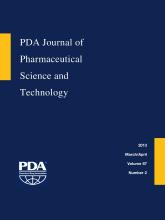Abstract
The purpose of this research is to evaluate Sterculia urens gum as a carrier for a colon-targeted drug delivery system. Microflora degradation studies of Sterculia gum was conducted in phosphate-buffered saline pH 7.4 containing rat caecal medium under an anaerobic environment. Solubility, swelling index, viscosity, and pH of the polymer solution were determined. Different formulation aspects considered were gum concentration (10–40%) and concentration of citric acid (10–30%) on the swelling index and in-vitro dissolution release. The results of the isothermal stress testing showed that there is no degradation of samples of model drug, azathioprine, the drug polymer mixture, and the core tablet excipients. Differential scanning calorimetry and Fourier transform infrared spectroscopy study proved the compatibility of the drug with Sterculia gum and other tablet excipients. Microflora degradation study revealed that Sterculia gum can be used as tablet excipient for drug release in the colonic region by utilizing the action of enterobacteria. The swelling force of the Sterculia gum could concurrently drive the drug out of the polysaccharide core due to the rupture of the mixed film coating under colonic microflora–activated environment. Sterculia gum gives premature drug release in the upper gastrointestinal tract without enteric coating and may not reach the colonic region. Sterculia gum as a colon-targeting carrier is possible via double-layer coating with chitosan/Eudragit RLPO (ammonio-methacrylate copolymer) mixed blend as well as enteric polymers, which would provide acid as well as intestinal resistance but undergo enzymatic degradation once reaching the colon.
LAY ABSTRACT: The aim of the research is to evaluate wheather Sterculia urens, which is a polysaccharide, is suitable as a carrier for colonic delivery of drugs acting locally in the colon. Sterculia gum has been reported to have wide pharmaceutical applications such as tablet binder, disintegrant, gelling agent, and as a controlled release polymer. Sterculia gum falls under the category of a polysaccharide and is yet to be evaluated as a carrier for colonic delivery of drugs. First the susceptibility of the polysaccharide gum in rat caecal microflora was investigated because true polysaccharides are degraded by the action of normal colonic bacteria. Bacterial degradation of the gum in the colonic environment was confirmed by adding a small quantity of the gum in rat caecal content mixed with phosphate-buffered saline pH 7.4 under an anaerobic environment. Solubility, swelling index, viscosity, and pH of the polymer solution were determined. Different formulation aspects considered were gum concentration (10–40%), concentration of citric acid (10–30%) on swelling index, and in vitro dissolution behavior. Isothermal stress testing was done to determine that there was no degradation of the model drug, azathioprine, with Sterculia gum excipient mixtures under stressed conditions. Differential scanning calorimetry and Fourier transform infrared spectroscopy study proved the compatibility of the drug with Sterculia gum and other tablet excipients. Microflora degradation study revealed that Sterculia gum is digested by the colonic microflora and therefore can be used as a tablet excipient for drug release in the colonic region utilizing the microflora degradation mechanism. Sterculia gum gives premature drug release in the upper gastrointestinal tract without enteric coating and may not reach the colonic region. Sterculia gum as colon-targeting carrier is possible via double-layer coating with chitosan/Eudragit RLPO (ammonio-methacrylate copolymer) and Eudragit L100 polymers, which would provide acid as well as intestinal resistance but undergo enzymatic degradation once reaching the colon.
- Sterculia gum
- Swelling index
- Microflora degradation
- Azathioprine
- Colon delivery
- Differential scanning calorimetry
- © PDA, Inc. 2013
PDA members receive access to all articles published in the current year and previous volume year. Institutional subscribers received access to all content. Log in below to receive access to this article if you are either of these.
If you are neither or you are a PDA member trying to access an article outside of your membership license, then you must purchase access to this article (below). If you do not have a username or password for JPST, you will be required to create an account prior to purchasing.
Full issue PDFs are for PDA members only.
Note to pda.org users
The PDA and PDA bookstore websites (www.pda.org and www.pda.org/bookstore) are separate websites from the PDA JPST website. When you first join PDA, your initial UserID and Password are sent to HighWirePress to create your PDA JPST account. Subsequent UserrID and Password changes required at the PDA websites will not pass on to PDA JPST and vice versa. If you forget your PDA JPST UserID and/or Password, you can request help to retrieve UserID and reset Password below.






